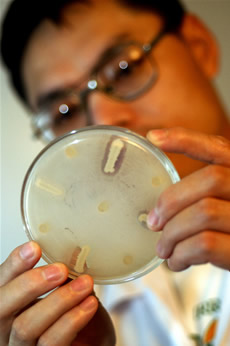 |
| Biopesticides |
Biopesticides allow biologically based, rather than chemically based, control of pests. A pest is any unwanted animal, plant, or microorganism. When the environment provides no natural resistance to a pest and when no natural antagonists are present, pests can run rampant.
For example, spread of the fungus Endothia parasitica, which entered New York in 1904, caused the nearly complete destruction of the American chestnut tree because no natural control was present. Viruses, bacteria, fungi, protozoa, mites, insects, and flowers have all been used as biopesticides.
Advantages of Biopesticides
Many plants and animals are protected from pests by passive means. For example, plant rotation is a traditional method of insect and disease protection that is achieved by removing the host plant long enough to reduce a region’s pathogen and pest populations.
  |
Biopesticides have several significant advantages over commercial pesticides. They appear to be ecologically safer than commercial pesticides because they do not accumulate in the food chain.
Some biopesticides provide persistent control, as more than a single mutation is required to adapt to them and because they can become an integral part of a pest’s life cycle. In addition, biopesticides have slight effects on ecological balances because they do not affect nontarget species. Finally, biopesticides are compatible with other control agents.
The major drawbacks to using biopesticides are the time required for them to kill their targets and the inefficiency with which they work; also, if the organism being used as a biopesticide is a nonnative species, it may cause unforeseen damage to the local ecosystem.
Viruses and Bacteria
 |
| Viruses and Bacteria |
Many commensal microorganisms (microorganisms that live on or in other organisms causing no direct benefit or harm) that occur on plant roots and leaves can passively protect plants against microbial pests by competitive exclusion (that is, simply crowding them out). Bacillus cereus has been used as an inoculumon soybean seeds to prevent infection by fungal pathogens in the genus Cercospora.
Some microorganisms used as biopesticides produce antibiotics, but the major mechanism in most cases seems to be competitive exclusion. For example, Agrobacterium radiobacter antagonizes Agrobacterium tumefaciens, which causes the disease crown gall.
Species of two bacterial genera—Bacillus and Streptomyces—when added as biopesticides to soil help control the damping-off disease of cucumbers, peas, and lettuce caused by Rhizoctonia solani. Bacillus subtilis added to plant tissue also controls stem rot and wilt rot caused by species of the fungus Fusarium.
Mycobacteria species produce cellulose degrading enzymes, and their addition to young seedlings helps control fungal infection by species of Pythium,Rhizoctonia, and Fusarium. Species of Bacillus and Pseudomonas produce enzymes that dissolve fungal cell walls.
Bacillus thuringiensis Toxins
The best examples of microbial insecticides are Bacillus thuringiensis (B.t.) toxins, which were first used in 1901. They have had widespread commercial production and use since the 1960’s and have been successfully tested on 140 insects, including mosquitoes.
Insecticidal endotoxins are produced by B.t. during sporulation, and exotoxins are contained in crystalline parasporal protein bodies. These protein crystals are insoluble in water but readily dissolve in an insect’s gut.
Once dissolved, the proteolytic enzymes paralyze the gut. Spores that have been consumed germinate and kill the insect. Bacillus popilliae is a related bacterium that produces an insecticidal spore that has been used to control Japanese beetles, a corn pest.
The gene for the B.t. toxin has also been inserted into the genomes of cotton and corn, producing genetically modified, or GM, plants that produce their own B.t. toxin. GM cotton and B.t. corn both express the gene in their roots, which provides them with protection from root worms.
Ecologists and environmentalists have expressed concern that constantly exposing pests to B.t. will cause insects to develop resistance to the toxin. In such a scenario, the effectiveness of traditionally applied B.t.would decrease.
Fungi and Protozoa
Saprophytic fungi can compete with pathogenic fungi. There are several examples of fungi used as biopesticides, such as Gliocladium virens, Trichoderma hamatum, Trichoderma harzianum, Trichoderma viride, and Talaromyces flavus. For example, Trichoderma species compete with pathogenic species of Verticillium and Fusarium.
Peniophora gigantea antagonizes the pine pathogen Heterobasidion annosum by three mechanisms: It prevents the pathogen from colonizing stumps and traveling down into the root zone, it prevents the pathogen from traveling between infected and uninfected trees along interconnected roots, and it prevents the pathogen from growing up to stump surfaces and sporulating.
Nematodes are pests that interfere with commercial button mushroom (Agaricus bisporus) production. Several types of nematode-trapping fungi can be used as biopesticides to trap, kill, and digest the nematode pests.
The fungi produce constricting and nonconstricting rings, sticky appendages, and spores, which attach to the nematodes. The most common nematode-trapping fungi are Arthrobotrys oligospora, Arthrobotrys conoides, Dactylaria candida, and Meria coniospora.
Protozoa have occasionally been used as biopesticide agents, but their use has suffered because of slow growth and the complex culture conditions associated with their commercial production.
Mites, Insects, and Flowers
Well-known “terminator” bugs include praying mantis and ladybugs as well as decollate snails, which eat the common brown garden snail. Fleas, grubs, beetles, and grasshoppers often have natural nematode species that prey on them, which can be used as biocontrol agents.
Predaceous mites are used as a biopesticide to protect cotton from other insect pests such as the bollwe evil. Parasitic wasps of the genus Encarsia, especially E. formosa, preyon whiteflies, as does Delphastus pusillus, a small, black ladybird beetle.
Dalmatian and Persian insect powders contain pyrethrins, which are a toxic insecticidal compounds produced in Chrysanthemum flowers. Synthetic versions of these naturally occurring compounds are found in products used to control head lice.